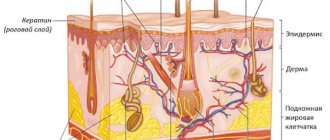In this article we will tell you:
- Colorblindness - what is it?
- Mechanism of anomaly
- Forms and types of color blindness
- Causes of color blindness
- Diagnosis of color blindness
- Correction of color blindness
Color blindness is probably one of the most famous ophthalmological diseases: both jokes and aphorisms are dedicated to it. However, most often they do not reflect the essence of the disease: therefore, in people’s minds it is often associated with symptoms and features that are unusual for it.
Read about what color blindness actually is, what its nature and mechanisms are, what types of color blindness there are, and whether there are ways to cure it.
Color blindness: a detailed description of the condition
Color blindness, about which much has been written on Wikipedia, is not a separate disease. This concept unites a whole group of color vision disorders, and individual varieties have different characteristics.
Colorblindness is popularly called color blindness, but this is not entirely true. Complete color blindness implies the absolute inability to see and distinguish any colors and shades, that is, a black and white perception of the world. But this is not the only form of color blindness. Much more often, so-called partial color blindness occurs, in which a color-blind person does not distinguish and confuses only certain tones.
Most often, colorblind people cannot distinguish at all or distinguish poorly and confuse any primary color of the palette. A person sees objects painted in this shade as different, for example, gray, dark brown, black (depending on the form of pathology). In certain forms of color blindness (complete color blindness), the color blind person cannot see absolutely any colors and tones, that is, he does not simply confuse them, but perceives objects in a grey-white-black range.
Interesting fact! According to world statistics, color blindness is much more common in men. Thus, among representatives of the fairer sex, impaired color perception occurs only in 0.4-0.5%. Men tend to confuse colors with color blindness in 5-9% of cases.
But what is color blindness, why does it develop? The mechanism of development of this pathology lies in the structure of the retina of the eye - the retina. It contains photosensitive special receptors that perceive light rays - cones and rods. Cones are responsible for color perception: they contain specific color-sensitive pigments of protein origin, divided into three separate types. Thanks to such cells, a person is able to see and easily distinguish between different shades and not confuse them.
Cones, depending on the pigments they contain, are responsible for the perception of three colors: green, blue and red. They are the main ones, and all other shades are formed by mixing the basics of the spectrum. Rods allow you to see objects in black and white in twilight or poor lighting conditions.
Cones capture and perceive light rays reflected from various objects. Color (blue, green or red spectrum) is determined by the length of the light wave, as well as the angle of its reflection from the surface. The receptors receive the signal received on the retina and send it along the optic nerve through nerve impulses to the brain, where all the information is processed and gives the person an idea of what and in what shade he sees.
With color blindness, the cones do not function correctly, which is why the task of color perception is not fully performed. Photosensitive receptors may not contain pigments at all, and in this case, a color blind person, due to color blindness, is unable to see and distinguish primary colors. Most often, one type of pigment is missing, so a person does not distinguish only one main part of the spectrum: either red, green, or blue.
If pigment protein compounds are present in the cones, but their concentration is insufficient for normal color perception, then the colorblind person will confuse the shades and see them differently than other people (for example, dull, excessively dark or grayish).
There is also another option for the development of color blindness. In this case, color incomplete blindness is accompanied by disturbances in the arrangement of pigments in photosensitive receptor cells. That is, the pigment is present, and there is enough of it, but it is not in the cones in which it should be. Because of this, colorblind people with this form of color blindness cannot see the entire gamut, do not distinguish between individual components of the spectrum, and confuse different shades. The picture of the world is perceived differently.
Good to know! Depending on what specific colors the colorblind person does not see, does not distinguish and confuses, there are several types of color blindness. There are dichromasia, protanopia, achromasia, tritanopia and other varieties.
Classification of congenital color vision disorders according to Nyberg-Rautian-Yustova
Main Difference
between them lies only in the verification of partial violations of color vision. According to the Nyberg-Rautian-Yustova classification, weakening of cone function is called color weakness, and depending on the type of photoreceptors involved, it can be divided into proto-, deuto-, tritodeficiency, and according to the degree of impairment - I, II and III degrees (in ascending order). There are no differences in the upper part of the schematically reflected classifications.
According to the authors of the latest classification, changes in color sensitivity curves are possible both along the abscissa axis (change in the range of spectral sensitivity) and along the ordinate axis (change in the sensitivity of cones). In the first case, this indicates an abnormality in color perception (abnormal trichromasia), and in the second, a change in color intensity (color weakness). Individuals with color weakness have reduced color sensitivity to one of three colors, and brighter shades of that color are needed for proper discrimination. The required brightness depends on the degree of color weakness. Abnormal trichromasia and color weakness, according to the authors, exist independently of each other, although they often occur together.
Color anomalies can also be divided according to the color spectrum
, the perception of which is impaired: red-green (protano- and deuteron violations) and blue-yellow (triton violations).
By origin,
all color vision disorders can be congenital or acquired.
The term “color blindness,” which has become widespread in our lives, is more of a slang term, since in different countries it can mean different color vision disorders. We owe its appearance to the English chemist John Dalton, who first described this condition in 1798, based on his feelings. He noticed that the flower, which during the day, in the light of the sun, was sky blue (or rather, the color that he considered sky blue), looked dark red in the light of a candle. He turned to those around him, but no one saw such a strange transformation, with the exception of his brother. Thus, Dalton realized that there was something wrong with his vision and that the problem was inherited. In 1995, studies were carried out on John Dalton's preserved eye, which revealed that he suffered from deuteranomaly. It usually combines “red-green” color vision disorders. Thus, despite the fact that the term color blindness is widely used in everyday life, it is incorrect to use it for any color vision disorder.
This article does not discuss in detail other manifestations of the organ of vision. Let us only note that most often patients with congenital forms of color vision disorders do not have any special disorders specific to them. Their vision is no different from that of an ordinary person. However, patients with acquired forms of pathology may experience various problems, depending on the cause of the condition (decrease in correctable visual acuity, visual field defects, etc.).
Historical reference
Wikipedia and other sources contain information that color blindness was first described many years ago - in 1794. A scientist from England named John Dalton, at the age of 26, noticed that he was unable to distinguish certain colors. In his case, the disorder was hereditary in nature, since signs also appeared in his siblings.
Dalton published his own scientific work describing color blindness and gave the phenomenon a name in honor of his last name. The scientist made a huge contribution, since further color blindness and various forms of disorders (protanopia, tritanopia and others) began to be actively studied.
General information
Color blindness is a condition that develops in a person due to the absence of retinal cells that are sensitive to color, or due to a malfunction in their functioning. The retina is the layer of nerves located at the back of the eye. These nerves are responsible for converting light into nerve signals, which in turn send information to the brain. Those who suffer from color blindness have an aversion to certain colors. As a rule, these red , blue , green or various combinations thereof. blindness in 1794 , guided by his own sensations.
After all, Dalton himself did not distinguish the color red; two of his brothers also had a similar disease. True, the scientist realized that he did not see the color red only when he was already twenty-six years old. Typically, the eye has three types of cone cells ( cone cells ). They are located in the retina and are sensitive to light. Each of the three types is sensitive to a specific color - red, blue, green. Accordingly, a person distinguishes colors; his conical cells determine the number of cells of the three named primary colors. If one or more of these types of cells are missing, or they do not work correctly, then a person does not see a certain color at all or distinguishes it in a modified form.
Basically, the cone cells are concentrated in the center of the retina, thus providing bright color vision. These cells perform best in good lighting, so in dim light, distinguishing colors becomes much more difficult.
Color blindness is also commonly called a “ color vision problem ”, because most people who are diagnosed with color blindness still partially distinguish the color gamut. However, many people with color blindness cannot distinguish colors at all.
Types of color blindness
Protanopia, total color blindness, and tritanopia are just a few distinct forms of color blindness, but other types also exist. So, according to Wikipedia and other sources, depending on the number of colors that a colorblind person is able to distinguish, dichromasia, trichromasia, monochromasia and achromasia (complete color blindness) are distinguished. Each of these types of color blindness is worth writing separately and in detail.
Trichromasia
With trichromasia, unlike protanopia and tritanopia, a person is able to see all three primary colors of the spectrum. There is normal trichromasia and also abnormal trichromasia. In the first case, a person is not considered colorblind, since he distinguishes colors, sees them correctly and does not confuse them.
With abnormal trichromasia, as with protanopia and tritanopia, there are deviations from the norm and clearly impaired altered color perception. Although a person is able to distinguish all colors and not confuse them, he sees them not so bright and intense. Colorblind people may perceive shades as faded, dull, dark or, on the contrary, excessively light.
Depending on the component of the spectrum, the color perception of which is distorted and impaired, the following forms of anomalous trichromasia are distinguished:
- Protanomaly (sometimes incorrectly called protanopia), which affects the perception of bright red hues.
- Deuteranomaly, characterized by the inability to adequately and fully perceive and differentiate shades of green.
- Tritanomaly (sometimes incorrectly called tritanopia), in which colorblind people cannot distinguish between blue and violet tones.
Achromasia
Achromasia is complete color blindness, in which color perception is completely absent, that is, a colorblind person sees all objects as black, gray or white. In its cones located on the retina (all three types) there are no pigments at all, so a person with such disorders cannot distinguish any colors. This type of color blindness is extremely rare.
Monochromacy
This type of color blindness is characterized by disruptions in color perception, in which a person is able to see and distinguish only one color of the gamut: only blue, only green, or exclusively red. This form is quite severe, often accompanied by concomitant pathologies, for example, high photosensitivity or photophobia, as well as nystagmus - involuntary, chaotic, uncontrolled, very fast and frequent oscillatory movements of the eyeballs.
Dichromasia, including protanopia, tritanopia and deuteranopia
Dichromasia, which includes separate forms of tritanopia, deuteranopia and protanopia, is a separate type of color blindness in which a person distinguishes two colors out of three possible. These can be any shades that are perceived by cones with color-sensitive pigments.
Dichromasy includes three distinct forms:
- Protanopia. The name protanopia comes from the Greek language, and “protos” is translated as the first (red was conventionally considered the first and main color of the spectrum). This deviation is the most common and occurs more often than others. Protanopia is characterized by incorrect color perception of shades of red. A colorblind person can see objects painted in this color as brown, gray, sometimes black, rarely dark green.
- Deuteranopia (“deteros” is translated from Greek as “second”). With this variety, a colorblind person does not perceive green tones, and he sees them as pinkish, pale orange.
- Tritanopia. The name is also Greek, “tritos” is the third, and that is the color blue. Tritanopia is a rather rare type of color blindness, the symptom of which is the lack of color perception of violet and blue gamuts. At the same time, the shades of red and green differ well. With tritanopia, the functioning of the rods located on the retina is also impaired, causing twilight vision to deteriorate.
Interesting fact! In some cases, color vision impairments are compensated by nature. For example, a colorblind person with protanopia, the main symptom of which is a violation of the color perception of the red gamut, is not able to differentiate red tones, but perceives shades of blue and green better, brighter and more acutely. And with tritanopia, the red and green gammas are clearly distinguishable.
Symptoms
- Healthy people are tritanopes - they can distinguish the entire color spectrum. Color vision impairments due to color blindness can be different:
Protanopia – difficulty perceiving the color red;
Anomalous trichromacy - all colors are perceived, only incorrectly - in other shades;
Monochromacy - only one color is perceived, usually blue;
Dichromacy - only one color disappears from perception;
Achromatia is a complete lack of color perception; the whole world is seen in black and white.
All these deviations are congenital.
Reasons for development
Wikipedia, as well as other reliable sources, says that most often protanopia, tritanopia and other types of color blindness are congenital. That is, the main reason is hereditary predisposition. The anomaly is formed at the stage of intrauterine development of the fetus due to a “broken” X chromosome. The carrier of the defective gene can be either a woman or a man, and sometimes color blindness is passed on through generations.
If a woman is the carrier of the defective gene, then she is likely to pass on color blindness to her son, but at the same time she herself can be completely healthy. In males, the “breakage” in the only X chromosome cannot be compensated for, since there is no other X chromosome. And that is why among men, deviations are 15-20 times more common.
For your information! There are also some congenital diseases in which the structure of the cones is disrupted. This happens with retinitis pigmentosa, pathological cone dystrophy or Leber amaurosis.
Acquired color blindness (including protanopia) occurs against the background of certain traumatic or thermal damage to the visual organs, as well as eye pathologies and diseases: cataracts, retinopathy in diabetes mellitus, glaucoma. Less commonly, altered color perception develops for other reasons - as a result of taking certain medications, Parkinson's disease, severe poisoning and intoxication, stroke and brain damage (occipital lobe).
Diagnosis of color blindness in the Nearmedic network of clinics
Diagnosing color blindness is not particularly difficult - there are special tests for this with color images. It is much more difficult to predict this chromosomal hereditary disease. To do this, the Nearmedic network of clinics conducts a DNA test for color blindness. During this highly accurate study, specific mutations are identified in the genotype of the woman - the expectant mother. After this, a conclusion is issued about the likelihood of this pathology in the unborn child.
If one of your relatives suffers from color blindness and you want to get all the information on this matter, contact us at +7 (495) 6 171 171.
The main manifestations of color blindness
What is the main sign of color blindness? How do colorblind people see colors, what colors can they not distinguish? This is written about on Wikipedia and in scientific works, and each case is individual. It all depends on what type of color blindness is diagnosed: tritanopia, anomalous trichromasia, protanopia or some other.
With complete color blindness, the picture of the world is perceived as black and white with gray transitions. With protanopia, tritanopia and deuteranopia, the color perception of objects is more vibrant and varied, but incorrect and different from the norm. Thus, protanopia is accompanied by the inability to differentiate the red gamut, deuteranopia – green, and tritanopia – violet and blue. What shades replace the indistinguishable tones? This depends on the structural features of the retina, namely its cones with color-sensitive protein pigments. The more such substances there are, the brighter and more diverse the spectrum.
Advice! In the photo and various images you can see how the colors of the world are approximately perceived by colorblind people with protanopia, achromasia, tritanopia, monochromasia and other varieties.
Professional restrictions
Despite the fact that a person with color blindness is not disabled, he is prohibited from entering a number of organizations and areas. A mandatory test for color perception is carried out when recruiting for aviation, marine and other industries where it is vital to be able to distinguish colors. At the same time, colorblind people became allowed to drive a car in Russia quite recently - only monochromatic people are not allowed to get a license. It should also be said that colorblind people are better at distinguishing related shades - for example, they are more successful at deciphering camouflage.
Diagnostics
To identify protanopia, tritanopia or other forms in men and women, you must contact an ophthalmologist for a specific diagnosis. The specialist conducts special tests.
Protanopia or tritanopia is usually immediately determined by testing using Rabkin's polychromatic tables. This method, developed in the middle of the last century, involves examining cards with various symbols. But the figures with numbers and backgrounds are not uniformly colored, but are created from small dots of different sizes and shades. If a person can easily determine what is shown on the card, he is doing well. If the test taker cannot see the symbols, then he is likely to have color blindness (protanopia, tritanopia, or another type). The Yustova, Ishihara and Stilling tests work on almost the same principle.
To identify color blindness, you should undergo testing, following several rules: keep images at eye level and at a meter distance, avoid bright lighting, look at signs for no longer than 5-7 seconds, remain in a calm and healthy state, and also use only paper media (screens). gadgets distort pictures).
Other diagnostic techniques are also used: the Holmgren method with the distribution of threads across three spectra of colors, the Falant test (studying the light of a lighthouse and two colored lanterns), as well as instrumental methods using specialized equipment developed by Nagel, Emney, Rabkin and Girenberg (spectroanomaloscope, anomaloscope and other patented devices).
Persons with acquired forms of color blindness are also advised to use other diagnostic procedures to assess the condition and structure of the visual organs: tonometry, biomicroscopy, refractometry, perimetry, ophthalmoscopy, ultrasound and others.
How to test a person for color blindness?
The main symptom of color blindness is the inability to see a particular range of color shades. To recognize pathology, ophthalmologists use special tests. The most common is the polychromatic test, which uses standard tables. It includes 27 pictures with geometric figures, symbols and numbers depicted on them, made up of multi-colored circles or spots. The size of the background spots is identical to the figure spots and differs only in color. Exactly 5 seconds are allotted for pattern recognition; the table is located approximately a meter from the patient’s eyes. A person with normal vision can easily distinguish an image highlighted only in color. If the perception of individual colors is impaired, the test can easily reveal this.
Identifying signs of color blindness in young children and people with mental retardation is possible only on the basis of indirect data. Pediatricians believe that children begin to distinguish colors well only by the third or fourth year of life, so young children should not be tested at all. The simplest test is to offer the child a choice of two identical objects, one of which will be gray and the other painted in a bright color. If a child chooses a colored object, then everything is fine with him. Parents should be wary if their child confuses colors while drawing: he paints a green sun, brown foliage or a red river.
Color blindness in children
Sometimes a man or woman discovers their peculiarity already in adulthood; impaired color vision is also diagnosed in school-age children during routine examinations. Often the diagnosis is made accidentally and suddenly, since a colorblind person may simply not know about the deviations if he sees the world in a certain way from birth and simply does not know other options for perception.
In most cases, color blindness is congenital, that is, it manifests itself immediately. But in the first months and even years, a small child is not able to clearly describe what he sees. And the ability to differentiate individual colors and tones is finally formed only by three or four years. But even at this age, diagnosis is complex and problematic, because even with protanopia or tritanopia, the child can describe some objects correctly. The sky will be blue, the blood will be red, and the grass will be green, because this is what your parents taught you. But how colors actually appear and are perceived by the eye is very difficult to determine.
To suspect tritanopia, achromasia, protanopia or another type of impaired color vision, you need to pay attention to the child’s behavior while drawing, modeling from plasticine or cutting out figures from colored paper. Parents can ask their son or daughter to make some object or character. And if a red apple turns out to be brown, then there is a chance that protanopia is present. And if the sea is not depicted as blue, then tritanopia can be suspected.
A young child usually does not experience difficulties if he has color blindness, which is not yet known. But in kindergarten, and even more so at school, problems can arise. To avoid difficulties, it is important to identify protanopia, tritanopia, deuteranopia or another type as early as possible, and after diagnosis, talk to the child and tell him that the feature distinguishes him from other people, but does not make him worse or ruin his life if he learns to adapt.
Cyanopsia
This is a pathology in which a person sees everything in blue tones.
This is a very rare pathology, always acquired. It occurs when the eye is injured, most often after removal of the lens, so many short light rays hit the retina. This makes it very difficult to perceive red and green shades. It can also occur due to inflammation in the retina. It happens that a person’s color perception is also reduced, and visual acuity is low.
Treatment
Is there a cure for color blindness? Congenital protanopia, tritanopia and any other type cannot be treated, but can be corrected. Specialized glasses with tinted lenses, thick frames or side shields are used to reduce the intensity of light that interferes with the perception of colors.
An innovative high-tech optical device with multilayer lenses that corrects the perception of primary colors has been developed in America. A huge breakthrough in treatment was made by the release of equipment that enhances the main parts of the spectrum and mutes or blocks halftones and shades.
There is a method for treating protanopia and other forms that is under development and has only been tested on monkeys. It involves the introduction of structure-changing viral particles into defective genes.
Acquired color blindness involves treatment of the underlying disease that impairs color perception. When the main reason for the change in color perception is eliminated, the functioning of the cones with color-sensitive pigments can be completely restored and normalized, if the violations were not irreversible.
Research
Early diagnosis of congenital color blindness is not easy, since newborns cannot yet reproduce their impressions of the world. However, there are screening methods that are especially used when parents are carriers of the gene or know that they may pass on the defective gene for color blindness.
One of the research methods is the so-called electroretinography. In this procedure, the eye is exposed to small flashes of light. Sensitive sensors use electrodes to measure the response of colored cones and visual stimuli. This data is represented as a waveform on an electroretinogram (ERG). From the course of the curve, ophthalmologists can infer color vision and the ability to see in the absence of light (twilight vision).
Another method is a blood test, which specifically looks for typical achromatopsia genes, which are studied in detail.
Correction of color blindness, or how to completely cure the pathology
Correction of color blindness depends on its type. It is corrected using EnChroma glasses with special lenses. This optics is suitable only for two types of pathology: protanopia and deuteranopia. The glass of these optical products has several coatings. They are filters that cut off part of the light rays of one spectrum or another. At the same time, they let the base colors through, enhancing the contrast between them.
When creating glasses, scientists made a model of the vision system of a person with impaired color perception. We installed various filters and calculated all the results. A program was developed to calculate the characteristics of lenses. It takes into account the characteristics of color blindness in each individual patient. These glasses have one drawback - they only work in natural light. However, today these optical products are a major achievement in the field of color blindness treatment. They are, of course, not cheap and are still rarely used.
There are other methods of correction - contact lenses. They work on roughly the same principle as EnChroma. Some patients are offered a monovision system, in which a special lens is placed on only one eye. This allows you to slightly expand the range of colors. But doctors and scientists cannot yet completely cure and correct color blindness.
Lenses for colorblind people
To enhance color perception, some people use special lenses, which are filters and can come in the form of contact lenses or spectacle lenses.
One example is the colorblind glasses developed by EnChroma. The tinted lenses in EnChroma's colorblind glasses, made with proprietary light-filtering technology, allow people with common forms of color blindness to see a wide range of the vibrant colors that most of us take for granted, the company says.
If you have color vision deficiency, you should see an eye doctor near you for advice on whether color blind glasses are right for you.
You can also learn how to get around your inability to see certain colors. For example, you can sort your clothes so you don't wear colors that don't match. (Ask your friends or family who have normal color vision to help you with this).
Learn to recognize some colored objects by their order rather than by color. In addition, you can download
different applications developed for Android and Apple devices that will help you determine the color.
Contact your eye doctor for additional help and guidance if you have difficulty seeing colors or if you suspect your child may be color blind.
How to identify a color perception disorder in a child
Even those who have never encountered a color disorder can imagine what it is. However, it is almost impossible to recognize color perception disorders in children under three years of age. At this age, kids begin to explore the world and because they see the objects around them, parents may suspect something is wrong. In this case, you can perform a couple of simple tests at home. For example, ask your child to draw grass or the sun. Another way to identify color blindness is to offer your child a choice of two candies. One of them should be in a bright red wrapper, the second - in silver. As a rule, children react to bright objects and reach for the red candy wrapper. But only a specialist can definitely determine the violation. If in doubt, the baby should be shown to an ophthalmologist. The doctor will determine what type of illness the child has or will report that there is no reason for concern.
Cure attempts
Today, scientists are making attempts to develop methods for treating color blindness. Some of them were successful. True, until now experiments have been carried out only on animals. In America, scientists performed surgery on two monkeys. They injected the animals into the retina of the eye with a harmless virus with a missing photoreceptor gene.
As a result, no violations occurred, and color sensitivity was restored. The monkeys began to distinguish between green and red shades of the spectrum. Such experiments have not yet been carried out on humans. But those suffering from this disease have hope for its cure. Medicine does not stand still and, perhaps, in the near future scientists will find a way to treat this disease.
In conclusion, people with color vision disorder have to face a number of problems. In addition to restrictions in choosing a profession, a lot of inconveniences arise in everyday life. They are associated with the choice of clothing and with difficulties in communicating with others. But we cannot help but say about the existing opinion that a violation of color perception can be evidence of genius. A number of world-famous scientists, artists, directors, and IT specialists were colorblind. For example, Facebook founder Mark Zuckerberg does not distinguish between red and green. That is why the social network was designed in blue tones.
Chloropsia
This is a similar disease, also always acquired.
With this disease, the eye loses the ability to see the colors of the red and blue spectrum, only green is perceived. It occurs with various organic poisonings of the body, with dystrophic and inflammatory phenomena in the retina. In this case, a person’s condition may worsen, the perception of green shades may also narrow, visual acuity may decrease, and intolerance to bright lighting may occur.
Mainly men are susceptible to it.
There is also such a temporary and fleeting condition as erythropsia - with it a person sees everything in a red color scheme.
In this case, white color is perceived as yellowish. This condition occurs after eye surgery, with “snow” blindness in skiers and climbers - it is also known as “snow blindness”, when the cornea is exposed to ultraviolet radiation (for example, when quartzing a room). It goes away quickly on its own and no treatment is required. If such vision does not go away within a couple of days, you should consult an ophthalmologist and wear good sunglasses for several days.








